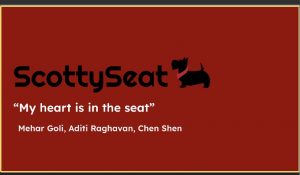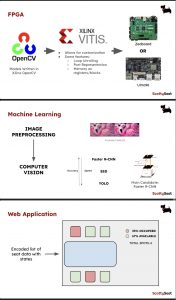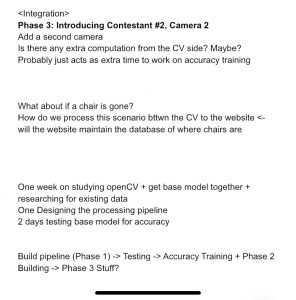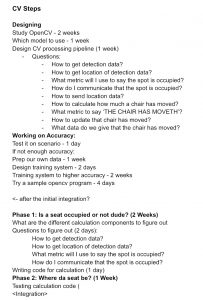After the presentation, we’ve gained various questions and suggestions from professors and peers regarding the user interface. Together, we decided to change from fixed seats mapping/dynamic seats mapping, to dynamic but insensitive to small movements(<1m)seat mapping, to reflect the position accurately but more friendly to users since small seat movements are not informative to users at all. To do this, at least for now, we will number the seats top left to bottom right to compare its current position to its last position. This will also address the case where a seat is removed or added, and free from frequent refresh. After this, we have our initial solution to the user interface. Other functions such as reserve seats or notification could also be implemented. I also looked a little bit into how exactly CV will be implemented, hopefully I may have the chance to participate in CV part if it time permits or it works out with my team.
Mehar’s Status Report for 9/24
My work was focused around pulling together the final presentation components and preparing for the proposal presentation, along with researching and planning the computer vision component of our project
My biggest accomplishment this week was the presentation, I did some reformatting through Sunday night along with rehearsing through Monday and Tuesday. I specifically added in some logos (Scotty dog, and ‘scottyseat’) to our slides and worked some more on our implementation slides


In terms of the overall project itself, my tasks included finding a study room to test in, deciding the final model for the computer vision component and studying OpenCV. As far as the study room, there was no need to look for one as we decided on the ECE lounge study rooms together.
I spent a bit of time going over old OpenCV notes I had and looking through the GitHub depositary for the current object detection model we are looking at, Faster R-CNN. The bulk of my time however was spent trying to rescope our computer vision segment and my portion of the Gantt chart.
With the feedback from the proposal, there were many new specifications to be met so I spent quite a bit of time to figure out what steps I need to take in the next few months to meet MVP.


With the rescoping process, I am a slightly behind on what I planned to study of OpenCV this week but I also now have a better idea of what I can focus on learning for the next week.
In the next week I hope to continue researching OpenCV to have the initial design of the computer vision backend, along with an initial version of the computer vision model up and running. This initial version would be implementing the existing pretrained model.
Team Status Report for 9/24
The implementation of our project has changed since the proposal presentation. After reading the feedback and discussing with the professors we realized that an FPGA was out of scope and also may take too much time to realistically do real time video processing. We have settled on using a NVIDIA Jetson TX2 instead. We also sat down and refined our solution for our use case. We have decided to use dynamic seat mapping, but only reflect an update in position if it moves > 1m. We discussed risk mitigation with seat tracking and occupancy by possibly using QR codes to uniquely identify chairs and whether they are occupied. We are in the process of redoing our task assignment and Gantt chart to allow for more time and earlier integration of all of our parts of the project.
Introduction and Project Summary
Study spots on campus are often hard to come by, you may search all of Tepper only to find there’s no space. By the time you’ve found a spot, 30 min may have passed that you could have spent working.
ScottySeat seeks to solve this issue by providing realtime updates on available study spots, and their locations. Building off of past study spot tracking projects, our project will run FPGA-accelerated computer vision algorithms on camera feed data to detect available study spots and communicate this data to the user via a web interface. The web interface will include a map of occupied/unoccupied spots along with overall occupancy of a given study space.
This project overall covers the areas of signals processing, hardware systems and software systems.
Hello world!
Welcome to Carnegie Mellon University: ECE Capstone Projects. This is your first post. Edit or delete it, then start blogging!
